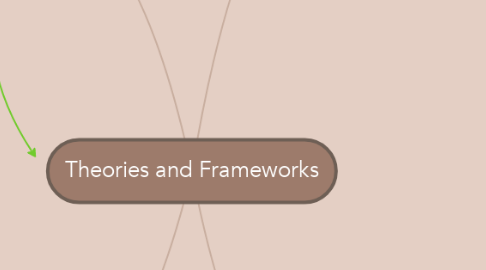
1. TPACK
1.1. There are three types of knowledge
1.1.1. Technology
1.1.1.1. Integration of technology within learning
1.1.2. Content
1.1.2.1. The knowledge of the information itself
1.1.3. Pedagogical
1.1.3.1. How the student is presented the information and how the learn it
1.2. These three knowledges work together in various ways to bring about successful teaching practices
2. Technology Theories
2.1. SCOT
2.1.1. Social Construction of Technology
2.1.2. Human action shapes technology; technology does not shape human action
2.1.3. Core Concepts
2.1.3.1. Interpretive Flexibility
2.1.3.1.1. Each technological artifact has different meanings and interpretations for various groups
2.1.3.2. Relevant Social Groups
2.1.3.2.1. Users and producers of the technological artifact (with subgroups)
2.1.3.3. Design Flexibilty
2.1.3.3.1. Multiple ways of constructing technology
2.1.3.4. Problems and Conflicts
2.1.3.4.1. The first stage is to reconstruct the alternative interpretations of the technology, analyze the problems and conflicts these interpretations give rise to, and connect them to the design features of the technological artifacts
2.1.3.5. Closure
2.1.3.5.1. Rhetorical Closure
2.1.3.5.2. Redefinition of the Problem
2.1.3.5.3. Second stage of SCOT is to show how closure is achieved
2.2. Media Ecology
2.2.1. Media and communication is crucial
2.2.2. McLuhan is vital to the research that has been done for Media Ecology
2.2.3. The study of media environments
2.2.4. The specific medium that is used makes a big difference
2.2.5. How media of communication affects human perception
2.2.6. The specifications of a media environment are often more informal and implicit
3. Philosophy of Teachnology
3.1. Very much like philosophy of teaching
3.2. The teachers opinion on the use of technology within their classroom
3.3. Includes technology use in all aspects of teaching: PLNs, classroom use, online learning, resources
3.4. My opinion: use in moderation.
3.5. TPACK influences is greatly
4. Learning theories
4.1. Constructivism
4.1.1. Learners can adapt if their new information contrasts what they already know
4.1.2. Uses challenging and authentic projects that include students, teachers and other members of the learning community
4.1.2.1. Collaboration brings new learning to the process and is a huge part of constructivism
4.1.3. Assume the responsibilities of their own leaning
4.1.3.1. Develop meta cognitive skills
4.1.4. Knowledge is constructed: learners build upon what is already known to them
4.1.4.1. Prior knowledge greatly influences what they are learning
4.2. Cognitive Load
4.2.1. Brain can only process so much information at a given time
4.2.2. Working memory vs Long Term memory
4.2.2.1. Long term memory: how long information stays in the brain and is accessible
4.2.2.2. Working memory: what the brain can work with, manage and manipulate at a given time (usually about 7 things at a time)
4.2.3. Everyone has a different method of processing the working memory
4.2.3.1. VARK can be used here to determine how a learner processes the information
4.2.3.1.1. Visual, Aural, Read/Write, Kinaesthetic
4.2.4. Long term memory is basically unlimited and assists the working memory
4.2.5. Three forms of Cognitive Load
4.2.5.1. Extraneous
4.2.5.1.1. Extraneous load is caused by inappropriate instructional designs that force working memory to focus away from building schemas into long term memory
4.2.5.2. Intrinsic
4.2.5.2.1. Intrinsic load is caused by the irreducible complexity of elements interacting in working memory
4.2.5.3. Germane
4.2.5.3.1. Germane load is caused by effortful learning resulting in Schema construction and the process of automation
4.2.6. Repetition, chunks, and "information landscapes" are useful for applying CLT
4.3. Connectivism
4.3.1. Includes technology and connection making as a learning activities
4.3.2. The integration of principles explored by chaos, network, and complexity and self-organization theories
4.3.3. Diversity of opinions; capacity to know more; use of non-human technology to gather, store and share information; nurturing and maintaining connections ; and up-to date information
